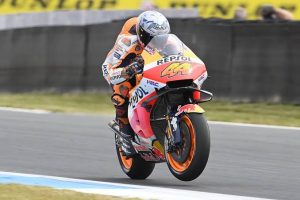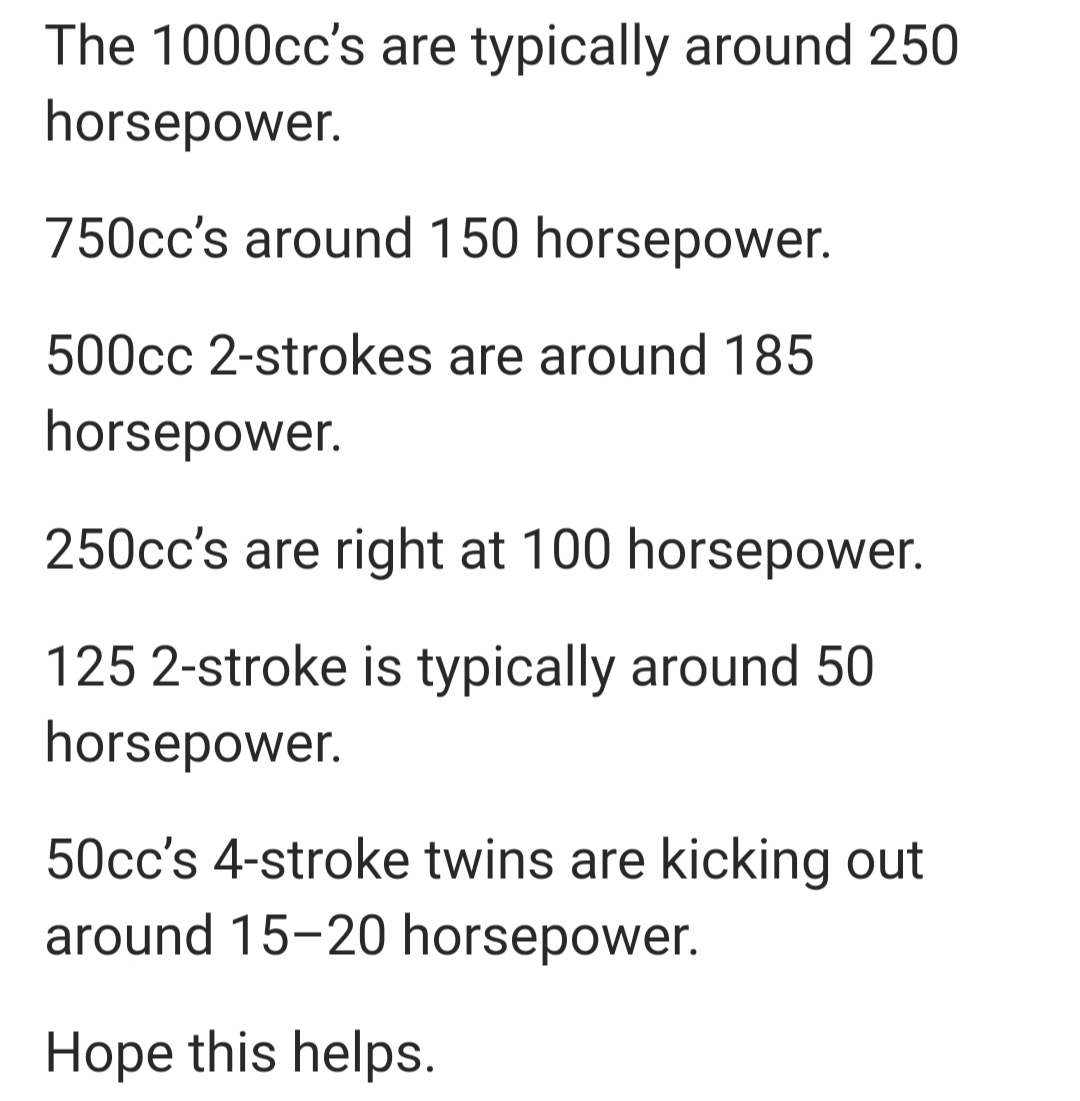A typical road bike in the 1000cc class has little more than 200 horsepower. With a bit of tweaking, the basic bike can produce approximately 230 horsepower.
MotoGP motorcycles are purpose-built and tuned to produce more power than a road bike.This most likely indicates more than 250 but less than 300.
Precisely where varies depending on the bike and the racetrack – they alter the engine sequencing to fit the track, handling conditions, tire longevity, and the rider’s interaction.”
So, in short, no one knows for sure, but 250–285 looks like a typical estimate.
Contents
What is the power of a MotoGP bike?
Power output varies in the premier class, with slower motorcycles producing 240–250hp and Ducati believed to produce up to 280hp.
Each team’s motors may also change performance by altering engine programming mid-race to conserve gasoline –
limiting fuel capacity has always been the easiest and yet most successful approach to preventing runaway expenses in engine technology to pursue greater power with decreasing investment returns.
How quick are MotoGP bikes?
It’s a well-known fact that a MotoGP bike can achieve over 350 km/h under the appropriate conditions.
So, what about the velocity at which the constituents move? A few of them move at lightning speed!
MotoGP motorcycles typically travel at speeds ranging from 160 to 185 km/h, depending on the track and circumstances.
Other speeds are not monitored as much and are not visible, but they are just as essential while riding this kind of machine.
The engine of a MotoGP motorcycle, for example, contains several moving components that move at various times and in different ways.
When the rider wants maximum power, the engine revs to 18,000 rpm. Each valve opens and shuts 150 times per second at such rates, which is impossible to comprehend.
Because of this movement’s strain on the components, pneumatic valves are required, as ordinary springs are not certified to endure this pressure.
When the engine is at maximum capacity, the injectors that feed the engine follow the same rhythm as the valves, executing approximately 9000 fuel infusions every minute.
The pistons travel at about 29 m/s, which is somewhat faster than 100 km/h. It may not appear to be much, but we are talking about an average speed of a part traveling roughly 48 mm from absolutely motionless to maximum speed and then slowing to a standstill.
As for other components, the motorcycle’s wheels can rotate at a rate of more than 50 revolutions per second at a speed of 300 km/h.
To put this in context, a washing machine operating at 1500 rpm makes just 25 revolutions per second.
During a circuit of the Americas, riders can make up to 30 gear changes, some of which are so quick that it appears there isn’t enough time.
On the other hand, the MotoGP bike can transition in one-tenth of a second, owing to the uninterrupted transmission.
Approximately 600 gear changes throughout a race equate to nearly 15 gear changes every minute, which is a lot when we compare it to what we do when driving along the road, especially in a city!
Is MotoGP more powerful than Superbike?
we can safely compare the Ducati’s MotoGP V-4 vasus the Panigale V4 R racing bike.
While comparing both you will find out that the Ducati’s MotoGP V-4 has or can produce a horse power of 275 hp while the Panigale V4 R racing bike is being rated just 221 hp.
Global Superbike vehicles are heavier and slower, like motorcycles you see on the road, unlike MotoGP bikes.
Superbikes compete on the same tracks as MotoGP regularly, allowing us to compare lap times.
This year’s WSB pole position for race two at Motorland Aragon, for example, was 1:49.884, which was lower than MotoGP’s time of 1:46.635.
The WSB series makes use of significantly modified production motorcycles equipped with manufacturing equipment and gadgets.
It must be a street-legal version of any manufactured superbike available for purchase anywhere globally, with limited room for improvement or change to the motorcycles. Restrictions surrounding superbikes are significantly stricter.
Do all MotoGP bikes have the same power?
The simple answer is No. MotoGP bikes have different producers, and each team always strives at making their bikes go that extra mile for the win.
So, however similar, there are still slight variations in their capacity.
What is the weight of a MotoGP bike?
While F1 vehicles weigh nine times the weight of the riders, MotoGP motorcycles weigh twice as much as an ordinary adult male and are challenging to control.
The tiny riders claim that large riders have an unfair edge when riding these massive motorcycles.
On the other hand, big riders are concerned with the notion of minimum weight for a bike and believe that by establishing a minimum weight, big riders will have a more significant potential to compete.
A MotoGP bike must weigh at least 157 kilos. If your motorcycle weighs less, you may be penalized for violating a technical restriction.
Moto2 and Moto3 have unified minimum weights, while MotoGP (up to 800cc or above) has a separate weight requirement.
The weight tested for the Moto2TM & Moto3TM classes is the rider’s sum with complete safety gear on top of that of the bike.
Because MotoGP bikes are mainly designed for specific riders rather than the public and are not legally accessible for purchase or driving for individuals like us, it is difficult for us to picture driving such a massive bike.
Engineers struggle to modify motorcycles to fit riders who aren’t of average build, and it’s much more challenging than ever for such riders to operate the bikes.
We’ll never know what goes on in the technical room, but we can get a sense of how much work it takes for a rider to ride these large motorcycles.
How many gears are on a MotoGP bike?
MotoGP bike has six gears and a neutral position.
MotoGP motorcycles have the first gear up and the rest of them down.
Downshifts are accomplished by pressing the lever down, while upshifts are made by pressing the lever up on regular bikes.
GP bikes, on the other hand, have it inverted.
On standard bikes, this is accomplished by rotating the actuator 180°.
This feature provides the rider with greater turning clearance because their foot is no longer underneath the gear shifter while upshifting.
`
Referenced sites;


